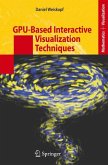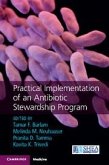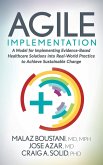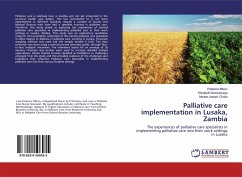Implementation Science
Theory and Application
Herausgeber: Nilsen, Per
Implementation Science
Theory and Application
Herausgeber: Nilsen, Per
- Gebundenes Buch
- Merkliste
- Auf die Merkliste
- Bewerten Bewerten
- Teilen
- Produkt teilen
- Produkterinnerung
- Produkterinnerung
This core textbook introduces the key concepts, theories, models and frameworks used in implementation science, and supports readers applying them in research projects.
Andere Kunden interessierten sich auch für
![Implementation Science in Nursing Implementation Science in Nursing]() Linda RousselImplementation Science in Nursing97,99 €
Linda RousselImplementation Science in Nursing97,99 €![Advancing the Science of Implementation Across the Cancer Continuum Advancing the Science of Implementation Across the Cancer Continuum]() Advancing the Science of Implementation Across the Cancer Continuum165,99 €
Advancing the Science of Implementation Across the Cancer Continuum165,99 €![GPU-Based Interactive Visualization Techniques GPU-Based Interactive Visualization Techniques]() Daniel WeiskopfGPU-Based Interactive Visualization Techniques122,99 €
Daniel WeiskopfGPU-Based Interactive Visualization Techniques122,99 €![Practical Implementation of an Antibiotic Stewardship Program Practical Implementation of an Antibiotic Stewardship Program]() Practical Implementation of an Antibiotic Stewardship Program83,99 €
Practical Implementation of an Antibiotic Stewardship Program83,99 €![Effectiveness of implementation Effectiveness of implementation]() Alain Mederos EspinosaEffectiveness of implementation29,99 €
Alain Mederos EspinosaEffectiveness of implementation29,99 €![Agile Implementation Agile Implementation]() MD MPH Malaz BoustaniAgile Implementation16,99 €
MD MPH Malaz BoustaniAgile Implementation16,99 €![Palliative care implementation in Lusaka, Zambia Palliative care implementation in Lusaka, Zambia]() Patience MboziPalliative care implementation in Lusaka, Zambia28,99 €
Patience MboziPalliative care implementation in Lusaka, Zambia28,99 €-
-
-
This core textbook introduces the key concepts, theories, models and frameworks used in implementation science, and supports readers applying them in research projects.
Hinweis: Dieser Artikel kann nur an eine deutsche Lieferadresse ausgeliefert werden.
Hinweis: Dieser Artikel kann nur an eine deutsche Lieferadresse ausgeliefert werden.
Produktdetails
- Produktdetails
- Verlag: Routledge
- Seitenzahl: 294
- Erscheinungstermin: 13. Mai 2024
- Englisch
- Abmessung: 260mm x 183mm x 20mm
- Gewicht: 752g
- ISBN-13: 9781032330853
- ISBN-10: 1032330856
- Artikelnr.: 70202876
- Herstellerkennzeichnung
- Libri GmbH
- Europaallee 1
- 36244 Bad Hersfeld
- gpsr@libri.de
- Verlag: Routledge
- Seitenzahl: 294
- Erscheinungstermin: 13. Mai 2024
- Englisch
- Abmessung: 260mm x 183mm x 20mm
- Gewicht: 752g
- ISBN-13: 9781032330853
- ISBN-10: 1032330856
- Artikelnr.: 70202876
- Herstellerkennzeichnung
- Libri GmbH
- Europaallee 1
- 36244 Bad Hersfeld
- gpsr@libri.de
Per Nilsen is a professor of social medicine and public health at Linköping University and a professor of implementation science at Halmstad University, Sweden.
1.Origins of the evidence movement. 2.The historical background of
implementation science. 3.Fundamentals of implementation science. 4. A
taxonomy of theories, models and frameworks in implementation science.
5.Process models. 6.Determinant frameworks. 7.Implementation theories.
8.Theories and concepts from other fields of potential utility for
implementation science. 9.Implementation strategies and outcomes. 10.Causal
pathway diagrams to understand how implementation strategies work.
11.Implementation science research methods. 12.Selecting theories, models
and frameworks. 13.Applying the Exploration, Preparation, Implementation,
Sustainment (EPIS) framework. 14.Applying the Consolidated Framework for
Implementation Research (CFIR). 15.Applying the integrated Promoting Action
on Research Implementation in Health Services (i-PARIHS) framework.
16.Applying the Tailored Implementation for Chronic Disease (TICD)
checklist. 17.Applying the Practical, Robust Implementation and
Sustainability Model (PRISM). 18.Applying Capability Opportunity Motivation
- Behaviour (COM-B) and the Theoretical Domains Framework (TDF).
19.Applying Normalization Process Theory (NPT). 20.Applying Reach
Effectiveness - Adoption Implementation Maintenance (RE-AIM). 21.A critique
of implementation science.
implementation science. 3.Fundamentals of implementation science. 4. A
taxonomy of theories, models and frameworks in implementation science.
5.Process models. 6.Determinant frameworks. 7.Implementation theories.
8.Theories and concepts from other fields of potential utility for
implementation science. 9.Implementation strategies and outcomes. 10.Causal
pathway diagrams to understand how implementation strategies work.
11.Implementation science research methods. 12.Selecting theories, models
and frameworks. 13.Applying the Exploration, Preparation, Implementation,
Sustainment (EPIS) framework. 14.Applying the Consolidated Framework for
Implementation Research (CFIR). 15.Applying the integrated Promoting Action
on Research Implementation in Health Services (i-PARIHS) framework.
16.Applying the Tailored Implementation for Chronic Disease (TICD)
checklist. 17.Applying the Practical, Robust Implementation and
Sustainability Model (PRISM). 18.Applying Capability Opportunity Motivation
- Behaviour (COM-B) and the Theoretical Domains Framework (TDF).
19.Applying Normalization Process Theory (NPT). 20.Applying Reach
Effectiveness - Adoption Implementation Maintenance (RE-AIM). 21.A critique
of implementation science.
1.Origins of the evidence movement. 2.The historical background of
implementation science. 3.Fundamentals of implementation science. 4. A
taxonomy of theories, models and frameworks in implementation science.
5.Process models. 6.Determinant frameworks. 7.Implementation theories.
8.Theories and concepts from other fields of potential utility for
implementation science. 9.Implementation strategies and outcomes. 10.Causal
pathway diagrams to understand how implementation strategies work.
11.Implementation science research methods. 12.Selecting theories, models
and frameworks. 13.Applying the Exploration, Preparation, Implementation,
Sustainment (EPIS) framework. 14.Applying the Consolidated Framework for
Implementation Research (CFIR). 15.Applying the integrated Promoting Action
on Research Implementation in Health Services (i-PARIHS) framework.
16.Applying the Tailored Implementation for Chronic Disease (TICD)
checklist. 17.Applying the Practical, Robust Implementation and
Sustainability Model (PRISM). 18.Applying Capability Opportunity Motivation
- Behaviour (COM-B) and the Theoretical Domains Framework (TDF).
19.Applying Normalization Process Theory (NPT). 20.Applying Reach
Effectiveness - Adoption Implementation Maintenance (RE-AIM). 21.A critique
of implementation science.
implementation science. 3.Fundamentals of implementation science. 4. A
taxonomy of theories, models and frameworks in implementation science.
5.Process models. 6.Determinant frameworks. 7.Implementation theories.
8.Theories and concepts from other fields of potential utility for
implementation science. 9.Implementation strategies and outcomes. 10.Causal
pathway diagrams to understand how implementation strategies work.
11.Implementation science research methods. 12.Selecting theories, models
and frameworks. 13.Applying the Exploration, Preparation, Implementation,
Sustainment (EPIS) framework. 14.Applying the Consolidated Framework for
Implementation Research (CFIR). 15.Applying the integrated Promoting Action
on Research Implementation in Health Services (i-PARIHS) framework.
16.Applying the Tailored Implementation for Chronic Disease (TICD)
checklist. 17.Applying the Practical, Robust Implementation and
Sustainability Model (PRISM). 18.Applying Capability Opportunity Motivation
- Behaviour (COM-B) and the Theoretical Domains Framework (TDF).
19.Applying Normalization Process Theory (NPT). 20.Applying Reach
Effectiveness - Adoption Implementation Maintenance (RE-AIM). 21.A critique
of implementation science.








